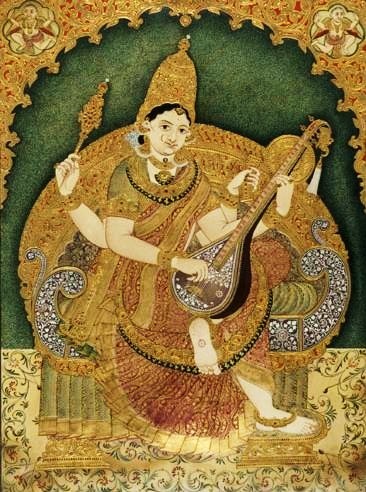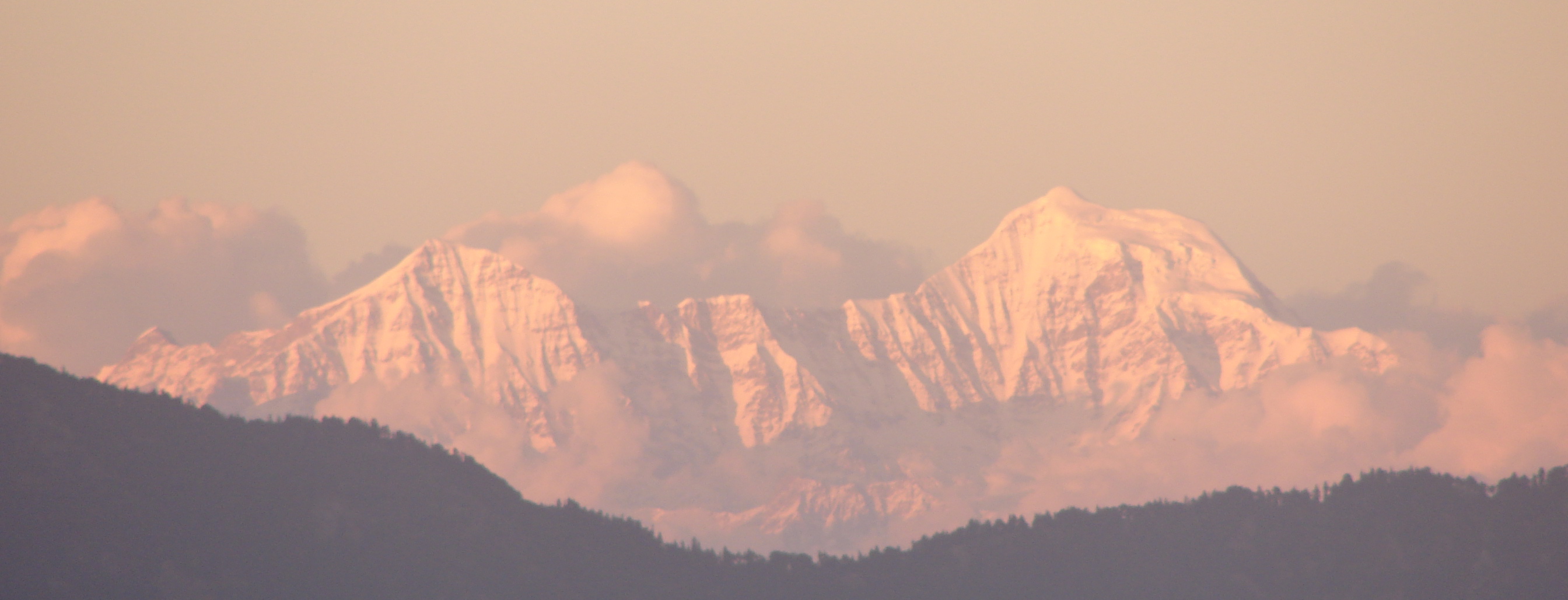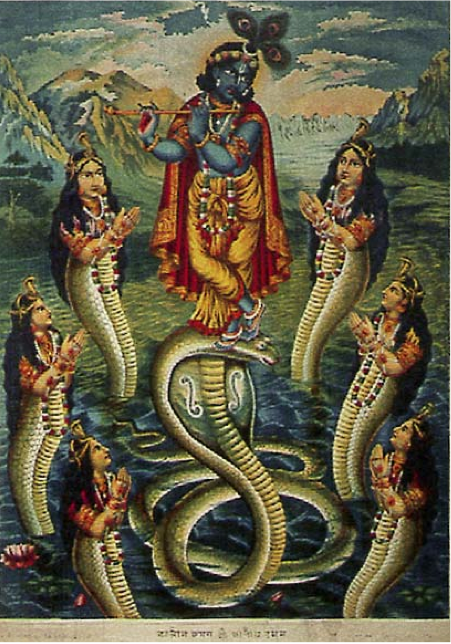|
Kalindi
Yamuna is a sacred river in Hinduism and the main tributary of the Ganges River. The river is also worshipped as a Hindu goddess called Yamuna. Yamuna is known as Yami in early texts, while in later literature, she is called Kalindi. In Hindu scriptures, she is the daughter of Surya, the sun god, and Sanjna, cloud goddess. She is also the twin sister of Yama, god of death. She is associated with the deity Krishna as one of his consorts, or Ashtabharya. Yamuna plays an important role in Krishna's early life as a river. According to Hindu scriptures, bathing in or drinking Yamuna's waters removes sin. Iconography Yamuna's iconographic depiction is seen on temple doorjambs, paired with that of Ganga (the goddess of the Ganges), since the Gupta era. The ''Agni Purana'' describes Yamuna as black in complexion, standing on her mount, the tortoise, and holding a water pot in her hand. In an ancient painting she is shown as a beautiful maiden standing on the banks of the river. Family ... [...More Info...] [...Related Items...] OR: [Wikipedia] [Google] [Baidu] |
Ashtabharya
The Ashtabharya or Ashta-bharya(s) is the group of eight principal queen-consorts of Hindu god Krishna, the king of Dvaraka in the Dvapara Yuga (epoch). The most popular list, found in the ''Bhagavata Purana'', includes: Rukmini, Satyabhama, Jambavati, Kalindi, Mitravinda, Nagnajiti, Bhadra, and Lakshmana. Variations exist in the ''Vishnu Purana'' and the '' Harivamsa'', which includes queens called Madri or Rohini, instead of Bhadra. Most of them were princesses. In Hinduism, all of Krishna's consorts including Radha are revered as the avatars of the goddess Lakshmi while the Gopis of Braj are considered as Radha's manifestations. Rukmini, the princess of Vidarbha was Krishna's first wife and chief queen (''Patrani'') of Dvaraka. She is considered as the avatar of Sridevi, the goddess of prosperity. Satyabhama, the third wife, a Yadava princess, is considered as Lakshmi's aspect of the earth-goddess Bhudevi. Jambavati is believed to be the manifestation of the third aspect o ... [...More Info...] [...Related Items...] OR: [Wikipedia] [Google] [Baidu] |
Krishna
Krishna (; sa, कृष्ण ) is a major deity in Hinduism. He is worshipped as the eighth avatar of Vishnu and also as the Supreme god in his own right. He is the god of protection, compassion, tenderness, and love; and is one of the most popular and widely revered among Indian divinities. Krishna's birthday is celebrated every year by Hindus on Krishna Janmashtami according to the lunisolar Hindu calendar, which falls in late August or early September of the Gregorian calendar. The anecdotes and narratives of Krishna's life are generally titled as ''Krishna Leela''. He is a central character in the ''Mahabharata'', the '' Bhagavata Purana'', the ''Brahma Vaivarta Purana,'' and the '' Bhagavad Gita'', and is mentioned in many Hindu philosophical, theological, and mythological texts. They portray him in various perspectives: as a god-child, a prankster, a model lover, a divine hero, and the universal supreme being. Quote: "Krsna's various appearances as a di ... [...More Info...] [...Related Items...] OR: [Wikipedia] [Google] [Baidu] |
Yamuna
The Yamuna (Hindustani language, Hindustani: ), also spelt Jumna, is the second-largest tributary river of the Ganges by discharge and the longest tributary in List of major rivers of India, India. Originating from the Yamunotri Glacier at a height of about on the southwestern slopes of Bandarpunch peaks of the Lower Himalayan Range, Lower Himalaya in Uttarakhand, it travels a total length of and has a Drainage system (geomorphology), drainage system of , 40.2% of the entire Ganges Basin. It merges with the Ganges at Triveni Sangam, Allahabad, which is a site of the Kumbh Mela, a Hindu festival held every 12 years. Like the Ganges, the Yamuna is highly venerated in Hinduism and worshipped as the Yamuna in Hinduism, goddess Yamuna. In Hinduism she is the daughter of the sun god, Surya, and the sister of Yama, the god of death, and so is also known as Yami. According to popular legends, bathing in its sacred waters frees one from the torments of death. It crosses several s ... [...More Info...] [...Related Items...] OR: [Wikipedia] [Google] [Baidu] |
Yamuna River
The Yamuna ( Hindustani: ), also spelt Jumna, is the second-largest tributary river of the Ganges by discharge and the longest tributary in India. Originating from the Yamunotri Glacier at a height of about on the southwestern slopes of Bandarpunch peaks of the Lower Himalaya in Uttarakhand, it travels a total length of and has a drainage system of , 40.2% of the entire Ganges Basin. It merges with the Ganges at Triveni Sangam, Allahabad, which is a site of the Kumbh Mela, a Hindu festival held every 12 years. Like the Ganges, the Yamuna is highly venerated in Hinduism and worshipped as the goddess Yamuna. In Hinduism she is the daughter of the sun god, Surya, and the sister of Yama, the god of death, and so is also known as Yami. According to popular legends, bathing in its sacred waters frees one from the torments of death. It crosses several states: Haryana and Uttar Pradesh, passing by Uttarakhand and later Delhi, and meeting its tributaries on the way, including ... [...More Info...] [...Related Items...] OR: [Wikipedia] [Google] [Baidu] |
River Deities In Hinduism
In Hinduism, rivers are often personified as deities. In the Rigveda, there are mentions of holy rivers such as the Sarasvati. The river Ganges is considered to be most sacred, and is personified as the goddess Ganga. Most of the rivers are represented in female form, with the notable exception of Brahmaputra, which is considered to be male. Historically, it is believed that the people of the Indus Valley civilisation worshipped the rivers. The most significant rivers in the faith are the ''Saptanadi'': the Ganges, Yamuna, Sindhu, Narmada, Godavari, Krishna, and Kaveri. Deities Ganga The Vedas and Puranas mention the river Ganges to be the most sacred river. In some legends, the goddess Ganga is daughter of Himavan (the personification of the Himalayas) and Menavati (an '' apasara''). She is the sister of the mother goddess, Parvati. She is the goddess of purity and purification, as people believe bathing in the Ganges removes sins and helps in gaining ''moksha''. Her mount ... [...More Info...] [...Related Items...] OR: [Wikipedia] [Google] [Baidu] |
Bhai Dooj
Bhai Dooj, Bhaubeej, Bhai Tika, Bhai Phonta or Bhratri Dwitiya is a festival celebrated by Hindus on the second lunar day of the Shukla Paksha (bright fortnight) of Kartika, the eighth month of the Vikram Samvat Hindu calendar or the Shalivahana Shaka calendar. It is celebrated during the Diwali or Tihar festival and Holi festival. The celebrations of this day are similar to the festival of Raksha Bandhan. In the southern part of India, the day is celebrated as Yama Dwitiya. In the Kayastha community, two Bhai Doojs are celebrated. The more famous one comes on the second day after Diwali. But the lesser-known one is celebrated a day or two after Diwali. In Haryana and Uttar Pradesh a ritual also followed, a dry coconut (named gola in regional language) with klewa tied along its width for worshipping is also used at the time of doing ''aarti'' of a brother.In Bengal the day is celebrated as Bhai Phota, which comes one day after Kali Puja. Regional names The festival is known as: ... [...More Info...] [...Related Items...] OR: [Wikipedia] [Google] [Baidu] |
Ganga
The Ganges ( ) (in India: Ganga ( ); in Bangladesh: Padma ( )). "The Ganges Basin, known in India as the Ganga and in Bangladesh as the Padma, is an international river to which India, Bangladesh, Nepal and China are the riparian states." is a trans-boundary river of Asia which flows through India and Bangladesh. The river rises in the western Himalayas in the Indian state of Uttarakhand. It flows south and east through the Gangetic plain of North India, receiving the right-bank tributary, the Yamuna, which also rises in the western Indian Himalayas, and several left-bank tributaries from Nepal that account for the bulk of its flow. In West Bengal state, India, a feeder canal taking off from its right bank diverts 50% of its flow southwards, artificially connecting it to the Hooghly river. The Ganges continues into Bangladesh, its name changing to the Padma. It is then joined by the Jamuna, the lower stream of the Brahmaputra, and eventually the Meghna, forming the major est ... [...More Info...] [...Related Items...] OR: [Wikipedia] [Google] [Baidu] |
Brahmana
The Brahmanas (; Sanskrit: , ''Brāhmaṇam'') are Vedic śruti works attached to the Samhitas (hymns and mantras) of the Rig, Sama, Yajur, and Atharva Vedas. They are a secondary layer or classification of Sanskrit texts embedded within each Veda, which explain and instruct on the performance of Vedic rituals (in which the related Samhitas are recited). In addition to explaining the symbolism and meaning of the Samhitas, Brahmana literature also expounds scientific knowledge of the Vedic Period, including observational astronomy and, particularly in relation to altar construction, geometry. Divergent in nature, some Brahmanas also contain mystical and philosophical material that constitutes Aranyakas and Upanishads. Each Veda has one or more of its own Brahmanas, and each Brahmana is generally associated with a particular Shakha or Vedic school. Less than twenty Brahmanas are currently extant, as most have been lost or destroyed. Dating of the final codification of the ''B ... [...More Info...] [...Related Items...] OR: [Wikipedia] [Google] [Baidu] |
Historical Vedic Religion
The historical Vedic religion (also known as Vedicism, Vedism or ancient Hinduism and subsequently Brahmanism (also spelled as Brahminism)), constituted the religious ideas and practices among some Indo-Aryan peoples of northwest Indian Subcontinent (Punjab and the western Ganges plain) during the Vedic period (1500–500 BCE). These ideas and practices are found in the Vedic texts, and some Vedic rituals are still practiced today. It is one of the major traditions which shaped Hinduism, though present-day Hinduism is markedly different from the historical Vedic religion. The Vedic religion developed in the northwestern region of the Indian subcontinent during the early Vedic period (1500–1100 BCE), but has roots in the Eurasian Steppe Sintashta culture (2200–1800 BCE), the subsequent Central Asian Andronovo culture (2000–900 BCE), and the Indus Valley civilization (2600–1900 BCE). It was a composite of the religion of the Central Asian Indo-Aryans, itself "a syncreti ... [...More Info...] [...Related Items...] OR: [Wikipedia] [Google] [Baidu] |
Kaliya
Kaliya (IAST: Kāliya, Devanagari: कालिय), in Hindu traditions, was a venomous Nāga living in the Yamunā river, in Vṛndāvana. The water of the Yamunā for four leagues all around him boiled and bubbled with poison. No bird or beast could go near, and only one solitary Kadamba tree grew on the river bank. The celebration of Nāga Nathaiyā or Nāga Nṛitya is associated with the tale of Lord Krishna dancing upon and subduing Kāliya. Story The story of Krishna and Kāliya is told in the sixteenth chapter of the Tenth Canto of the ''Bhagavata Purana''. The proper home of Kāliya was the island of Ramaṇaka, but he had been driven away from there in fear of Garuḍa, the foe of all serpents. Garuḍa had been cursed by the yogi Saubhari dwelling at Vrindavan so that he could not come to Vrindavan without meeting his death. Therefore, Kāliya chose Vrindavan as his residence, knowing it was the only place where Garuḍa could not come. Once, the sage Durva ... [...More Info...] [...Related Items...] OR: [Wikipedia] [Google] [Baidu] |
Shiva
Shiva (; sa, शिव, lit=The Auspicious One, Śiva ), also known as Mahadeva (; ɐɦaːd̪eːʋɐ, or Hara, is one of the principal deities of Hinduism. He is the Supreme Being in Shaivism, one of the major traditions within Hinduism. Shiva is known as "The Destroyer" within the Trimurti, the Hindu trinity which also includes Brahma and Vishnu. In the Shaivite tradition, Shiva is the Supreme Lord who creates, protects and transforms the universe. In the goddess-oriented Shakta tradition, the Supreme Goddess ( Devi) is regarded as the energy and creative power (Shakti) and the equal complementary partner of Shiva. Shiva is one of the five equivalent deities in Panchayatana puja of the Smarta tradition of Hinduism. Shiva has many aspects, benevolent as well as fearsome. In benevolent aspects, he is depicted as an omniscient Yogi who lives an ascetic life on Mount Kailash as well as a householder with his wife Parvati and his three children, Ganesha, Kartikeya and A ... [...More Info...] [...Related Items...] OR: [Wikipedia] [Google] [Baidu] |
Sati (goddess)
Sati (, sa, सती, , ), also known as Dakshayani (Sanskrit: दाक्षायणी, IAST: ''Dākṣāyaṇī'', lit. 'daughter of Daksha'), is the Hindu goddess of marital felicity and longevity, and is worshipped as an aspect of the mother goddess Shakti. She is generally considered the first wife of Shiva, the other being Parvati, who was Sati's reincarnation after her death. The earliest mentions of Sati are found in the time of the Ramayana and the Mahabharata, but details of her story appear in the Puranas. Legends describe Sati as the favourite child of Daksha, who marries Shiva against her father's wishes. After Daksha humiliates her and her husband, Sati kills herself in the yajna (Fire-Sacrifice) to protest against him, and uphold the honour of her husband. In Hinduism, both Sati and Parvati, successively play the role of bringing Shiva away from ascetic isolation into creative participation with the world. Sati's story plays an important part in shaping the ... [...More Info...] [...Related Items...] OR: [Wikipedia] [Google] [Baidu] |





_(2).jpg)


.png)


